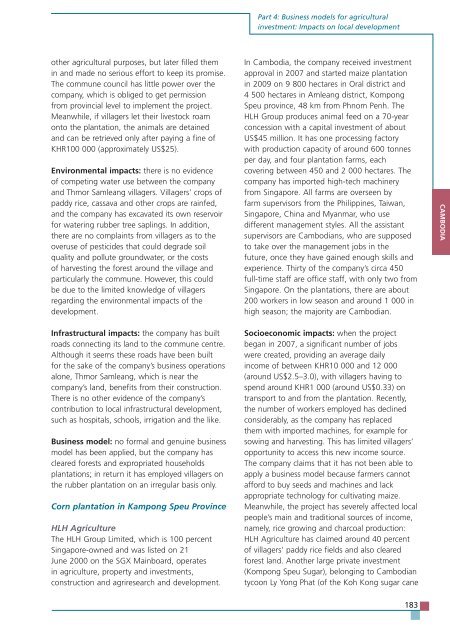TRENDS AND IMPACTS OF FOREIGN INVESTMENT IN DEVELOPING COUNTRY AGRICULTURE
TRENDS AND IMPACTS OF FOREIGN INVESTMENT IN DEVELOPING COUNTRY AGRICULTURE
TRENDS AND IMPACTS OF FOREIGN INVESTMENT IN DEVELOPING COUNTRY AGRICULTURE
Create successful ePaper yourself
Turn your PDF publications into a flip-book with our unique Google optimized e-Paper software.
other agricultural purposes, but later filled them<br />
in and made no serious effort to keep its promise.<br />
The commune council has little power over the<br />
company, which is obliged to get permission<br />
from provincial level to implement the project.<br />
Meanwhile, if villagers let their livestock roam<br />
onto the plantation, the animals are detained<br />
and can be retrieved only after paying a fine of<br />
KHR100 000 (approximately US$25).<br />
Environmental impacts: there is no evidence<br />
of competing water use between the company<br />
and Thmor Samleang villagers. Villagers’ crops of<br />
paddy rice, cassava and other crops are rainfed,<br />
and the company has excavated its own reservoir<br />
for watering rubber tree saplings. In addition,<br />
there are no complaints from villagers as to the<br />
overuse of pesticides that could degrade soil<br />
quality and pollute groundwater, or the costs<br />
of harvesting the forest around the village and<br />
particularly the commune. However, this could<br />
be due to the limited knowledge of villagers<br />
regarding the environmental impacts of the<br />
development.<br />
Infrastructural impacts: the company has built<br />
roads connecting its land to the commune centre.<br />
Although it seems these roads have been built<br />
for the sake of the company’s business operations<br />
alone, Thmor Samleang, which is near the<br />
company’s land, benefits from their construction.<br />
There is no other evidence of the company’s<br />
contribution to local infrastructural development,<br />
such as hospitals, schools, irrigation and the like.<br />
Business model: no formal and genuine business<br />
model has been applied, but the company has<br />
cleared forests and expropriated households<br />
plantations; in return it has employed villagers on<br />
the rubber plantation on an irregular basis only.<br />
Corn plantation in Kampong Speu Province<br />
HLH Agriculture<br />
The HLH Group Limited, which is 100 percent<br />
Singapore-owned and was listed on 21<br />
June 2000 on the SGX Mainboard, operates<br />
in agriculture, property and investments,<br />
construction and agriresearch and development.<br />
Part 4: Business models for agricultural<br />
investment: Impacts on local development<br />
In Cambodia, the company received investment<br />
approval in 2007 and started maize plantation<br />
in 2009 on 9 800 hectares in Oral district and<br />
4 500 hectares in Amleang district, Kompong<br />
Speu province, 48 km from Phnom Penh. The<br />
HLH Group produces animal feed on a 70-year<br />
concession with a capital investment of about<br />
US$45 million. It has one processing factory<br />
with production capacity of around 600 tonnes<br />
per day, and four plantation farms, each<br />
covering between 450 and 2 000 hectares. The<br />
company has imported high-tech machinery<br />
from Singapore. All farms are overseen by<br />
farm supervisors from the Philippines, Taiwan,<br />
Singapore, China and Myanmar, who use<br />
different management styles. All the assistant<br />
supervisors are Cambodians, who are supposed<br />
to take over the management jobs in the<br />
future, once they have gained enough skills and<br />
experience. Thirty of the company’s circa 450<br />
full-time staff are office staff, with only two from<br />
Singapore. On the plantations, there are about<br />
200 workers in low season and around 1 000 in<br />
high season; the majority are Cambodian.<br />
Socioeconomic impacts: when the project<br />
began in 2007, a significant number of jobs<br />
were created, providing an average daily<br />
income of between KHR10 000 and 12 000<br />
(around US$2.5–3.0), with villagers having to<br />
spend around KHR1 000 (around US$0.33) on<br />
transport to and from the plantation. Recently,<br />
the number of workers employed has declined<br />
considerably, as the company has replaced<br />
them with imported machines, for example for<br />
sowing and harvesting. This has limited villagers’<br />
opportunity to access this new income source.<br />
The company claims that it has not been able to<br />
apply a business model because farmers cannot<br />
afford to buy seeds and machines and lack<br />
appropriate technology for cultivating maize.<br />
Meanwhile, the project has severely affected local<br />
people’s main and traditional sources of income,<br />
namely, rice growing and charcoal production:<br />
HLH Agriculture has claimed around 40 percent<br />
of villagers’ paddy rice fields and also cleared<br />
forest land. Another large private investment<br />
(Kompong Speu Sugar), belonging to Cambodian<br />
tycoon Ly Yong Phat (of the Koh Kong sugar cane<br />
183<br />
CAMBODIA


